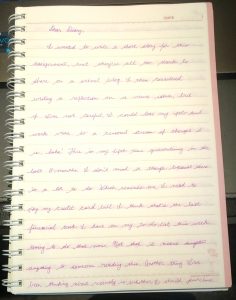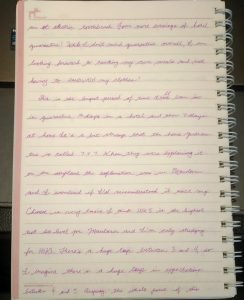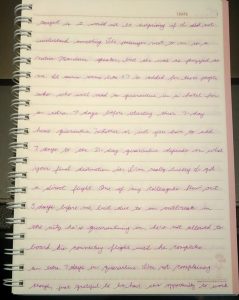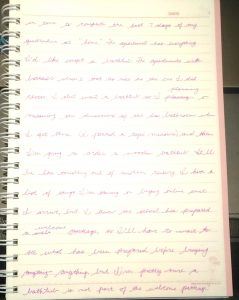




->T4.Manual.Scripts.Sheena.Chan<-
Please click the above link to read my reflection on the task.
Or Read it below.
Manual Scripts Commentary
I have a work journal and a personal journal that I write by hand in every day. This
task was a bit difficult because I knew it might be read by others, so I put more effort
than I normally would into writing legibly. Usually, I do not write this much by hand in
one sitting, so I did find my hand becoming a bit tired and it showed up in my
penmanship. If I make a wording mistake, I crossed out the word and rewrote the correct
word above or beside the cross out. If I made a spelling mistake or wrote illegibly, I would
either cross it out or write the correct letters over the incorrect letters. Just as Gutenberg
could have argued that the printing press’ accuracy, economy and speed makes it better
(Ewart, 2021), this process made me appreciate the efficiency of my laptop, but when I
choose to write by hand in my personal life, the intended audience is myself, so I appreciate the segment when Robert Lamb and Joe McCormick (2021, 6:35) spoke of the
written word’s ability to “freeze” a moment of the mind books’ ability to retain and
reclaim lost knowledge. I saw a correspondence between this and my belief that mistakes
can be viewed as “lost thoughts.” When rereading my hand written work, I also look at
the words I crossed out and try to pick up the train of thought that brought me to that
word. Sometimes these words lead to a new idea or entry. During writing I encourage my
students to cross out their mistakes with a single line so their mistakes are still legible. I
believe it was the scientist Richard Feynman who developed a new theory from discarded
notes that he’d kept. Just like Feynman, I perceive my mistakes to be memory crystals
waiting to be distilled and refined at the right moment.
My typed work is used to interact with others, but I seldom directly interact with my
typed work after it has been sent out. Professionally I do have to write many things by
hand, but unlike what I hand write in my personal life, they are short-lived and often
disappear with the swipe of a board eraser. While these writings exist on the board, I and
my students interact with this text. If the purpose of a text is to be interacted with,
perhaps these temporary texts meet this definition better than the others I create due to
the number of people who interact with them and how they can be changed and added
to almost instantly. On the other hand, while the written words may disappear, these
texts often transform into oral knowledge because most students will lose their notes or
throw them out at the end of the school year. At the beginning of this task, I considered
oral texts to have little place within my life, but actually most of the texts I create
professionally are transformed into oral texts that students share in discussions at school
and home. While text technologies will transform how we view and use texts, humans’
need for face-to-face communication make it impossible to remove the oral component of texts.
References
Ewart, K. (2021). Economies of writing-or-writing about writing [Course reading]. Canvas. https://canvas.ubc.ca/courses/89383/pages/4-dot-3-economies-of-writing-orwriting-about-writing?module_item_id=3341898
Lamb, R. & McCormick J. (Hosts). (2021, May 26). The invention of the book, part 1 [Audio podcast
episode]. In Stuff to blow your mind. iHeartRadio. https://www.iheart.com/podcast/stuff-toblow-your-mind-21123915/episode/the-invention-of-the-book-part-63031174/

Hi Sheena,
I appreciated your explanations on the process you went through to create a clearly legible handwritten text. Your approach to this task was quite different from mine, since I created a set of potato stamps which made me appreciate how difficult it is to create legible typefaces – so painstaking! The natural fluidity of handwriting seems like the opposite to creating a typeface.
What I found especially interesting in your explanations were your musings on errors being ‘lost thoughts’. This is extremely interesting to me, especially as we learn more about the way we are writing more and more using computers (word processors), which make it so easy to ‘fix’ errors as we type, so these ‘lost thoughts’ seem less likely to be preserved. How many theories have been lost to the ‘backspace’ and ‘delete’ keys? I know we can use ‘track changes’ in Word to see how our writing has changed over time, but I wonder how many of us would use that tool while developing a text? What about you? How do you preserve your lost thoughts when typing into a computer? Do you feel that ‘lost thoughts’ merit the same value in a typed document on a computer as they do on a handwritten page?
Thanks for your interesting reflections!
Delian
Thanks for your comment and question, Delian. I think handwriting was the easier choice for this task, but once you have created the typefaces, I imagine it’d be easier to produce large quantities of text! Handwriting is only easy now because I spent the first couple years of elementary school practising, haha.
I think the value of lost thoughts has the same potential in a typed document or a handwritten page. Personally, if I’m writing an important document, I’ll handwrite key ideas and phrases onto paper before and during typing because I find it easier to sort through ideas when they’re handwritten. I don’t remember when I make changes, but I do remember where on the page I’ve added ideas.